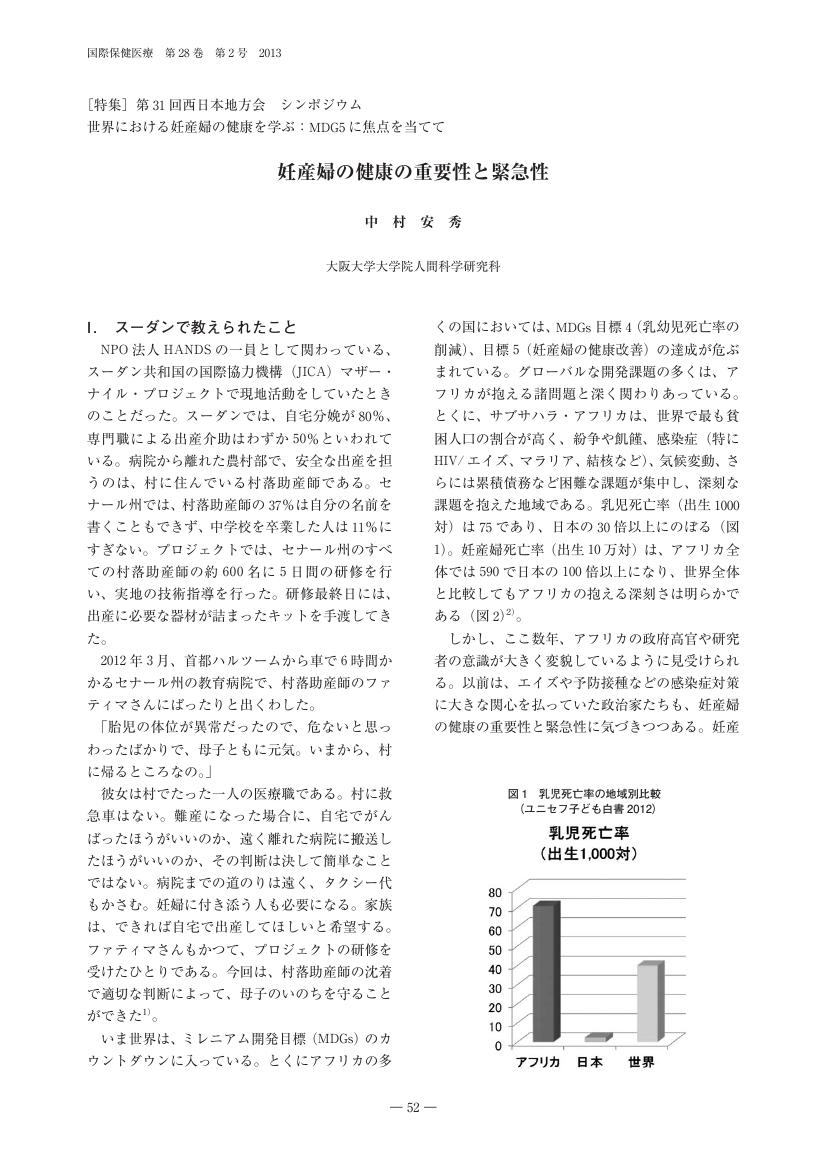- 著者
- 辻元 清美 戸羽 太 荒井 優 大西 健丞 中村 安秀
- 出版者
- 国際ボランティア学会
- 雑誌
- ボランティア学研究 (ISSN:13459511)
- 巻号頁・発行日
- no.13, pp.3-24, 2013-02-15
- 著者
- 佐伯 壮一朗 柳澤 沙也子 小笠原 理恵 安田 直史 中村 安秀 関西グローバルヘルスの集い運営委員会
- 出版者
- 日本国際保健医療学会
- 雑誌
- 国際保健医療 (ISSN:09176543)
- 巻号頁・発行日
- vol.36, no.2, pp.63-72, 2021 (Released:2021-07-22)
- 参考文献数
- 10
背景 新型コロナウイルス感染症(Novel Coronavirus Disease 2019, COVID-19)の影響を受け、各種イベント開催が自粛され、人が物理的に集まらないオンラインセミナーの開催の需要が高まっている。しかし、オンラインセミナーの開催経験を豊富に有するグローバルヘルス関連の学術団体はまだ少なく、ノウハウの蓄積は不十分である。そのような状況の中、公益社団法人日本WHO協会は一般市民に開かれた公開講座「関西グローバルヘルスの集い」を「COVID-19とSDGs」をテーマに2020年3月から企画し、5月より3回オンラインにて開催した。この経験に基づきオンラインセミナーを開催する際の主催者への注意点をまとめる。開催概要 関西グローバルヘルスの集いを開催するにあたりオンラインで参加者の募集、登録受付を行った。その際Google Formsを利用し、参加者の属性に対するアンケート調査を実施した。本番はオンライン会議ソフトウェアZOOMを使用し、動画サイトYouTubeにて生配信した。視聴者動向の解析はYouTube Analyticsによる自動解析を利用し、セミナー終了後、参加登録者にGoogle Formsを利用したアンケートでフィードバックを依頼した。 3回の参加者はのべ2,083名だった。大半は日本在住であったが、海外在住の参加者はのべ69名で、欧米諸国やチュニジア、ザンビアなどであった。参加者の属性は医療者のみならず大学教員や学生、会社員も参加した。満足度について、5段階評価で4以上を回答した参加者は85.7%であった。記述回答では内容への肯定的な意見の他、開催前から当日にかけての運営の不手際を指摘した意見が寄せられた。教訓 オンラインセミナーでは、講演内容のみならず運営の手際でも満足度が変化することが分かった。運営の不手際は具体的に、セミナー開催前には一部の参加者に対し配信用URLが届かない例があり、セミナー中には画面の切り替えの不手際、画面共有で投影していたスライドの動作不全が生じたこともあった。これらは運営側の取り組み次第では予防あるいは早期発見し修正する余地があり、不具合が生じた際の対応を事前に検討することが重要である。結論 オンラインセミナーを開催することで視聴者のみならず登壇者は世界中から参加可能となったのは大きな利点である。一方、綿密な準備が必要で、運営者の経験を蓄積し円滑な運営を行うことは議論活性化の最低条件である。今後、国際保健医療分野での活用のためにはオンラインセミナーの運営のみならず内容の質も問われることとなるだろう。
2 0 0 0 OA 在日外国人の人口学的特徴と児童福祉の課題
- 著者
- 北野 尚美 李 錦純 中村 安秀
- 出版者
- 一般社団法人日本衛生学会
- 雑誌
- 日本衛生学雑誌 (ISSN:00215082)
- 巻号頁・発行日
- vol.74, pp.18032, 2019 (Released:2019-04-19)
- 参考文献数
- 32
- 被引用文献数
- 1
In this study, we examined the changes in the demographic characteristics of foreign residents in Japan (FRJ) and the current status of FRJ from a global health perspective. We also considered child maltreatment that occurred in FRJ families and language problems in child welfare. Japan’s official statistics in the end of 2017 indicated that there were more than 2.56 million FRJ from over 190 countries. This population was diverse with heterogeneous characteristics, such as age structure, dwelling place, marital status, and childbirth. At the end of 2017, there were 219,982 FRJ children aged 0–14 of various nationalities, including Chinese, Brazilian, South Korean, North Korean, Filipino, Vietnamese, Peruvian, Nepalese, and Indian. In 2010, we conducted our first survey of child maltreatment in FRJ families, targeting 219 child protection centers across Japan. Between April 2007 and August 2010, 1,639 child maltreatment cases were reported from 56% of these centers. Details of 1,111 cases were collected and descriptive analyses were conducted. The male-to-female ratio was 0.88 and the median age was 8 years: however, the age distribution showed that females were significantly older than males (P < 0.01). The proportions of physical abuse, child neglect, emotional abuse, and sexual abuse were 38%, 33%, 21%, and 7%, respectively. Native language problems created numerous challenges and required a large amount of effort from child welfare practitioners. However, most solutions to identified problems were still at the beginning stage and some were found to be ineffective. More interdisciplinary and integrated researches are needed targeting child welfare of FRJ. An ethical framework for good counseling practices should be developed.
2 0 0 0 OA 抗生物質を用いた自己治療と薬剤師の対応
- 著者
- 木村 暁 中村 安秀
- 出版者
- 日本国際保健医療学会
- 雑誌
- 国際保健医療 (ISSN:09176543)
- 巻号頁・発行日
- vol.29, no.2, pp.81-90, 2014-06-20 (Released:2014-07-17)
- 参考文献数
- 29
目的 途上国では処方箋を必要とする薬剤の販売規制が不十分であり、薬剤耐性の発現という視点からも、抗生物質による自己治療は世界の公衆衛生の大きな問題である。インドネシアにおいては処方箋薬による自己治療は一般的であるうえに危険な偽造医薬品の流通も社会問題となっている。インドネシア首都圏において抗生物質を買い求める顧客の行動様式とそれに対する薬剤師の対応を明らかにし、抗生物質を用いた自己治療に係る要因を考察することを目的とした。方法 南タンゲラン市チプタ地区における地域薬局6店で抗生物質を求めた200名の顧客に出口調査を行った。調査項目は健康保険加入・非加入を含めた一般属性のほか、来店時の処方箋の有無、購入にあたっての薬剤師の指示の有無など構造化質問表を用いた。また薬局に勤務する薬剤師、薬局経営者ら8名に半構造化インタビューを行った。調査項目は一日に抗生物質を買い求める顧客数、そのうち処方箋を持たない顧客の割合、薬剤師の顧客対応、経験した健康被害の有無などとした。調査は2012年5月下旬から7月初めにかけて実施した。結果 薬局に抗生物質を買い求めに来た顧客の48.5% (97/200)が処方箋を持っていなかった。医師の受診か自己治療か、という選択は健康保険の加入の有無と有意に関連していなかった。処方箋を持たない患者が抗生物質を購入するときは飲み残しサンプルを薬局で提示するケースが51.9% (54/104)を占め、家族・友人あるいは薬剤師の推薦などに従うケースに比べて有意に多かった。薬剤師は薬剤耐性とアレルギー発現に留意して問診を行い,処方箋を持たない顧客に抗生物質を交付することは慎重であった。薬剤師は自己治療の問題を軽減するために顧客や地域への働きかけと患者教育が重要であると考えていた。結論 健康保険の加入状況が処方箋の有無及び医師の受診頻度と有意に相関しなかったことは自己治療の選択が経済的要因だけではないことを示すものと考えられた。顧客の自信過剰な態度、飲み残しサンプルでの購入、家族・友人の勧めを薬剤師の勧めに優先させる傾向などから自己治療は限られた経験や情報に基づくヒューリスティックな選択であると同時に限られた選択肢の中でのリスクマネジメントであると考えらえた。 抗生物質は治療効果が短期間で明白となることから高い学習効果と成功体験をもたらして自己治療に好都合である。この成功体験が自己治療の選択行動を強化していることが考えられた。行動変容を促す患者教育は薬剤師の新たな役割と期待される。
- 著者
- 塩崎 恭久 辻元 清美 遠山 清彦 西村 ちなみ 大西 健丞 中村 安秀
- 出版者
- 国際ボランティア学会
- 雑誌
- ボランティア学研究 (ISSN:13459511)
- 巻号頁・発行日
- vol.7, pp.49-70, 2007-02-28
1 0 0 0 アフガニスタン-大阪間の遠隔講義の国際配信
- 著者
- 松河 秀哉 井上 聡一郎 中村 一彦 下山 富男 吉田 雅巳 重田 勝介 吉田 健 前迫 孝憲 景平 義文 関 嘉寛 内海 成治 中村 安秀 下條 真司
- 出版者
- 日本教育工学会
- 雑誌
- 日本教育工学雑誌 (ISSN:03855236)
- 巻号頁・発行日
- vol.27, pp.189-192, 2004
- 参考文献数
- 4
- 被引用文献数
- 3
大阪大学人間科学研究科はアフガニスタンとの間で遠隔講義を実施し,その内容を他機関と連携して広く一般に公開した.アフガニスタン側は衛星携帯電話(ISDN64Kbpsの通信機器を接続可能),大阪大学側は衛星携帯電話と相互通信可能なISDN公衆回線を用いて接続し.ISDN回線に対応するテレビ電話で映像・音声を伝送した.その内容は大阪大学内でリアルタイムに編集され,多くの機関の協力を得て,インターネットと通信衛星を使って国際配信された.配信された講義は,少なくとも海外8カ国で受信された.アフガニスタンからの講義は,現地にいる様々な分野の専門家の協力を得て進められ,学生が積極的に質問する姿が認められた.
目的 東日本大震災被災地,岩手県陸前高田市において震災後から継続して未来図会議(保健医療福祉包括ケア会議から名称変更)が実施されている。この会議が果たしてきた役割を分析し,今後の災害対応計画への一助とする。<br/>方法 未来図会議創成期の保健医療福祉関係者10人(行政 6 人,行政以外 4 人)への聞取り結果,既存資料による情報収集を基に,経済協力開発機構開発援助委員会(OECD/DAC)による評価 5 項目を用いて分析した。<br/>結果 被災直後,市関係者は支援調整対応に追われ現状確認と情報集約が出来ない状況にあった。元市職員の支援者が調整役となり初回会議が2011年 3 月27日に開催され,参加者は官民区別なく全保健医療福祉関係者とされた。各方面の現状情報共有と支援調整が行われ,5 月には復興に向けた課題共有を開始した。6 月末までほぼ毎週開催され,災害援助法救護班派遣が終了した 7 月より月 1 回の開催となった。参加者はその頃より現地職員を主とし,地元市民団体,外部支援団体となり,中長期的課題共有と対応検討をし続け,現在に至る。<br/> DAC 評価 5 項目別に以下の結果が得られた。①妥当性:被災後の現状把握,情報共有,支援調整の場として機能した。②有効性:行政,民間,支援関係者が共通認識をもち役割を確認し,支援連携を生む機会となった。③効率性:支援の需要と供給のマッチング機会を創出した。知恵が集積され新たな視点や効果的な活動を生み,支援の効率化に貢献した。④インパクト:関係者への知識普及と課題の共通理解を促進した。包括的ニーズ把握が施策化に活かされた。⑤自立発展性:早期からの復興イメージ提示により課題共有がされ,行政・民間双方において復興に関し検討する必要な場として認識されている。<br/>結論 災害時の国際協力では効率的支援と最大限の支援効果を目的とするクラスターアプローチが実施される。専門分野ごとにパートナーシップを構築し支援調整を行うものだが,未来図会議は,緊急期,復旧期においてこのクラスターアプローチの役割を担っていた。復興期以降は全関係者が中長期的課題を共有し検討できる場として役割を担っている。このような未来図会議の取組みは今後の災害対応計画において一つのモデルとなり得る。<br/> 提言として①早期に情報交換の場を立ち上げること,②会議参加者の資格は問わず自由参加とすること,③地元既存組織を含め民間組織との平時からの関係構築,が挙げられた。
- 著者
- 中村 安秀
- 出版者
- 国立社会保障・人口問題研究所
- 雑誌
- 海外社会保障研究 (ISSN:13443062)
- 巻号頁・発行日
- no.192, pp.20-24, 2015
- 著者
- 井上 千尋 松井 三明 李 節子 中村 安秀 箕浦 茂樹 牛島 廣治
- 出版者
- 日本国際保健医療学会
- 雑誌
- 国際保健医療 (ISSN:09176543)
- 巻号頁・発行日
- vol.21, no.1, pp.25-32, 2006 (Released:2006-06-09)
- 参考文献数
- 17
本研究は、東京都心の医療機関における、1990年から2001年まで12年間の外国人分娩事例のうち、日本語によるコミュニケーションが困難な事例について検討することにより、言語の問題に伴う在日外国人の周産期医療上の課題を明らかにし、その対策について考察した。日本語によるコミュニケーションが困難なことにより、医療従事者と妊産婦との適切な意思伝達の阻害、保健・医療・福祉に関する情報不足、の2点が特有の問題として挙げられた。特に意思伝達の阻害は、病歴や自覚症状の確認困難、相互信頼関係形成と精神的支援の阻害、医療従事者の負担の増大を引き起こし、さらにインフォームドコンセントに基づく医療サービス提供の妨げになっていた。外国人妊産婦に対して、日本人と同じようにインフォームドコンセントに基づいた医療を提供するには、医療通訳制度を整えることが急務の課題であると考えられた。
- 著者
- 中村 安秀 島尾 忠男 石井 明 喜多 悦子 石川 信克 加藤 美寿季
- 出版者
- 日本国際保健医療学会
- 雑誌
- 国際保健医療 (ISSN:09176543)
- 巻号頁・発行日
- vol.31, no.4, pp.347-367, 2016-12-20 (Released:2017-01-23)
1 0 0 0 OA 外国人医療における医療通訳者の現状と課題 —医療通訳者に対する質問紙調査より—
- 著者
- 伊藤 美保 飯田 奈美子 南谷 かおり 中村 安秀
- 出版者
- 日本国際保健医療学会
- 雑誌
- 国際保健医療 (ISSN:09176543)
- 巻号頁・発行日
- vol.27, no.4, pp.387-394, 2012-12-20 (Released:2013-01-24)
- 参考文献数
- 22
目的本研究は、医療通訳を実施している当事者に対して質問紙調査を行い、医療通訳業務や研修の内容、医療通訳の現場での課題などを明らかにすることを目的とした。方法通訳者を派遣しているNPO、地域の国際化協会や、通訳者を雇用している医療機関等に通訳者への配布を依頼し、郵送にて直接回収し分析した。結果有効回答数は284名(有効回答率33.4%)であった。5年以上の経験者が46.1%いたが、常勤の通訳者は少なく、76.4%が派遣の形態をとっていた。対応言語は、手話を含む14言語であった。通訳頻度が月4回以下のものが68.3%であったが、8.5%は月20回以上の医療通訳の機会があった。回答者の54.4%が総時間20時間以上の研修を受けていた。医療従事者と患者の間に位置する通訳者として、種々の困難さに直面している実態が明らかになった。考察医療通訳者を直接対象とした本調査により、すでに多くの医療通訳者が現場で活動している実態が明らかとなった。研修を受ける機会が少なく、通訳技術の維持向上に必要不可欠な研修体制の充実が必要であった。医療従事者側と患者側の双方に、通訳者の効果的な活用方法と公平性という業務範囲を明確に説明し、同時に通訳者を精神的にも支える立場のコーディネーターが必要である。
1 0 0 0 OA 「系統的文献検索概説」書評
- 著者
- 中村 安秀
- 出版者
- 日本国際保健医療学会
- 雑誌
- 国際保健医療 (ISSN:09176543)
- 巻号頁・発行日
- vol.28, no.1, pp.27-27, 2013-03-20 (Released:2013-04-11)
1 0 0 0 OA 妊産婦の健康の重要性と緊急性
- 著者
- 中村 安秀
- 出版者
- 日本国際保健医療学会
- 雑誌
- 国際保健医療 (ISSN:09176543)
- 巻号頁・発行日
- vol.28, no.2, pp.52-55, 2013-06-20 (Released:2013-07-30)
- 参考文献数
- 7


